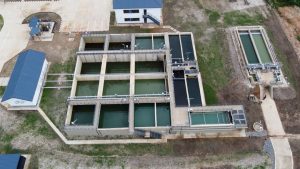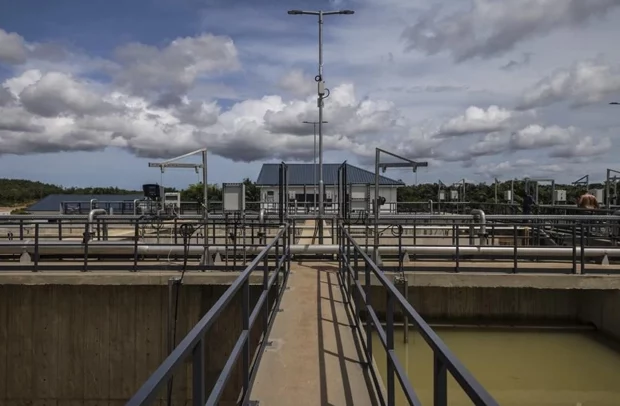Flocculation system of newly designed plant
In 2021, a quiet yet groundbreaking transformation unfolded in the Sekyere Hemang township of Ghana’s Agona District when the Sekyere Hemang Wastewater Treatment Plant underwent an ambitious upgrade that has since been hailed as a defining moment in the nation’s approach to water and wastewater management.
Spearheaded by Amoh Tontoh, a Senior Water and Wastewater Engineer whose innovative vision has placed him at the forefront of sustainable infrastructure development, this project not only rescued a struggling local facility but also established a new benchmark for Ghana and West Africa in balancing urban growth with environmental preservation. The challenge facing Sekyere Hemang was immense and urgent. The original treatment facility, designed decades earlier for a smaller population, was overwhelmed by the explosive growth of wastewater volumes resulting from urbanization and population increase. The outdated systems struggled to meet environmental standards, leaving the nearby Achiase River in peril. This river was more than a water body; it was the heartbeat of the community, sustaining fishermen, providing irrigation for farmers, and serving as a vital resource for thousands of families. Yet each passing year increased the risk of contamination, threatening aquatic life, jeopardizing food security, and placing the health of residents in grave danger through waterborne illnesses. Local businesses and households bore the brunt of the crisis, facing rising costs due to deteriorating water quality and a lack of reliable treatment infrastructure.
The stakes were not merely local but national, as the situation reflected a wider challenge Ghana faced in managing its growing urban centers without compromising natural ecosystems. Against this backdrop, Amoh Tontoh envisioned a comprehensive solution that married engineering innovation with ecological stewardship. At the heart of the project was a dramatic increase in the plant’s treatment capacity – 13 million liters daily, equivalent to the water volume of five Olympic-sized swimming pools. This was achieved through the installation of advanced biological nutrient removal bioreactors designed to strip harmful nitrogen and phosphorus, thereby protecting aquatic habitats.
Complementing these were upgraded blower systems that improved aeration efficiency, ensuring more effective breakdown of organic matter. Two massive 31-meter secondary clarifiers, among the largest of their kind in the region, were constructed to significantly improve water clarity and pollutant removal. To handle sludge, often the most difficult byproduct of treatment plants, a cutting-edge rotary drum thickener coupled with cooled storage tanks was introduced, transforming waste management into a safer and more efficient process. Beyond technological upgrades, the project prioritized environmental safeguards.
A custom-designed groundwater dewatering system was installed to shield existing structures from potential water damage, while carefully engineered conveyance pipelines, laid across challenging and ecologically sensitive terrain, were fortified with specialized encasement to protect the Achiase River from accidental leakage or seepage. Perhaps the most revolutionary element was the integration of Supervisory Control and Data Acquisition (SCADA) systems paired with Programmable Logic Controllers (PLCs). This allowed operators to monitor every stage of treatment in real-time, respond instantly to fluctuations, and optimize plant performance with unparalleled precision. The impact of these measures was both immediate and profound.

Schematic of the treatment plant
The Ghana Water Company Limited quickly recognized the groundbreaking nature of the Sekyere Hemang upgrade, formally adopting its design as the new benchmark for wastewater treatment nationwide. Its innovative approach has since influenced expansions of smaller modular packet plants in neighboring districts, particularly in areas where space is limited and ecosystems are vulnerable. Engineers across Ghana now look to the Sekyere Hemang model for guidance in designing systems near rivers, wetlands, and other sensitive habitats, where the use of screw pumps and environmentally conscious piping systems has proven particularly effective.
The environmental recovery was dramatic. Within months of the plant’s completion, Environmental Impact Assessments confirmed that the protective barriers and advanced treatment mechanisms had successfully halted contamination of the Achiase River. Fish populations rebounded in striking numbers, biodiversity flourished, and the surrounding ecosystems, once under severe threat, began to regenerate. For residents, the improvements were tangible: a sharp decline in cases of waterborne illness, lower medical bills, improved household well-being, and reduced costs for local businesses that depend on clean and reliable water resources.
The project restored trust in the ability of infrastructure to not only support growth but also protect the natural environment. More broadly, the Sekyere Hemang transformation offered a powerful lesson for Ghana and for West Africa as a whole: that sustainable urban development and environmental preservation are not opposing forces but natural allies when approached with foresight, skill, and a commitment to long-term stewardship.
Today, the legacy of Sekyere Hemang extends beyond the boundaries of Agona District. Engineering students in several university in Ghana study its systems as a model of environmentally responsive design. Municipal planners cite it as a case study when advocating for investments in modern wastewater infrastructure. National policy discussions reference it as proof that Ghana can lead Africa in pioneering green infrastructure solutions that meet the dual demands of urbanization and ecological preservation. International observers have also taken note, with environmental and engineering bodies praising the project as a replicable model for developing nations navigating similar challenges. At its core, the Sekyere Hemang Wastewater Treatment Plant Improvement Project is more than a technical upgrade—it is a philosophical shift in how infrastructure is conceived and implemented. It demonstrates that with visionary leadership, communities can achieve growth without sacrificing their rivers, ecosystems, or public health. As Amoh Tontoh himself has stated, “Our goal was not simply to build a bigger plant, but to prove that engineering can safeguard our future while meeting the needs of today.” That goal was not only met but exceeded, leaving behind a blueprint for 21st-century infrastructure that continues to inspire a new generation of engineers, policymakers, and community leaders across Ghana and beyond. The ripple effects of this quiet revolution are still spreading, shaping the course of sustainable development in West Africa and standing as a shining testament to the transformative power of engineering grounded in environmental responsibility.
By Emmanuel Agyei


